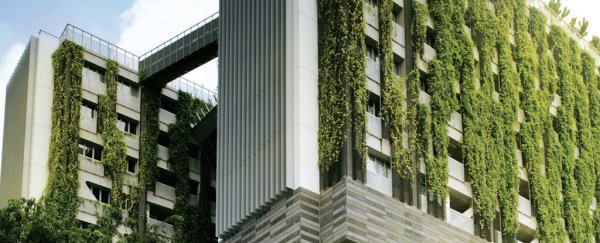Buildings covered in a carpet of vegetation and greenery are sprouting up all over the world - look at One Central Park in Sydney, Bosco Verticale in Milan, or Oasia Hotel Downtown in Singapore.
But why are architects and planners going green? Design firm Arup just published a study on the benefits of plant-covered buildings - some of which are so green they look like they've been deserted by humans and are slowly being reclaimed by nature - and they found the benefits go way beyond just sucking up CO2 and looking pretty.
The company's engineers took a variety of measurements in five cities - Berlin, Hong Kong, Melbourne, London, and Los Angeles - to see what impact extra greenery could have.
First of all, there's the obvious one: plants pull carbon dioxide out of the air and convert it into oxygen. With the number of green spaces in our cramped urban areas at a premium, moving shrubs and trees onto buildings is one way to ensure this essential process keeps going around us.
Green coverings can significantly reduce other pollutants in the air as well, including soot and dust. Research has shown that even a plant on your desk can improve the quality of the air inside your home.
While a couple of skyscrapers might not fix city-wide smog problem, the Arup study found that pollutants in the air between two plant-covered buildings could be reduced by as much as 20 percent.
Green buildings also cool down our cities by blocking the 'urban heat island effect', where buildings and roads radiate heat on hot days.
As Adele Peters at Fast Company reports, Arup modelled what densely populated cities would be like with more green facades, and found that in high-rise cities such as Hong Kong, green buildings could lead to temperature reductions of up to 10 degrees Celsius (18 degrees Fahrenheit).
And in the height of summer, they found that a roof covered in vegetation could maintain the same temperature as the ambient air temperature, whereas a non-green roof can get up to an incredible 50 degrees Celsius hotter in the blazing sun (90 degrees Fahrenheit).
With our planet getting warmer and warmer, we could really use some vegetation to counter these effects.
Thanks to the shade provided by these green coverings, indoor temperatures are often reduced, too, and if the facades are built in the right way, noise pollution can also be absorbed.
A covering of foliage won't block out the din of traffic completely, but the study found it did have positive effects, particularly in the evening and on distant, more ambient sounds.
Another positive impact that's not immediately obvious is better drainage - with plants and shrubs there to soak up rainwater and delay the time it takes water to get from sky to ground, the damaging effects of flash floods aren't as severe.
The study also notes other benefits that are more difficult to measure: better well-being for office workers who can enjoy more nature (and cleaner air), plus a more diverse urban ecology, allowing insects and plants to flourish.
And the good news is that these green facades can be fitted to existing buildings. According to the team behind the report, solar panels and vertical farming systems can easily be added.
Cities that are more eco-friendly, cleaner, quieter, safer, cooler and more pleasant to work in - not bad for a few layers of plant life.
"We now have the opportunity to rethink how cities can improve green infrastructure and, at the same time, help to reduce energy consumption, improve air quality and people's wellbeing," says the Arup Cities Alive report.
